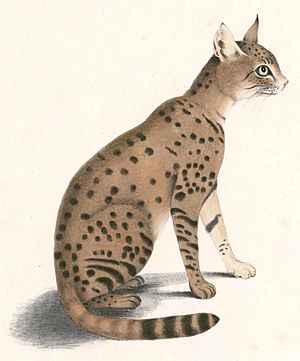Asiatic wildcat facts for kids
Quick facts for kids Asiatic wildcat |
|
|---|---|
 |
|
| Conservation status | |
| Scientific classification | |
| Kingdom: | |
| Class: | |
| Order: | |
| Family: | |
| Genus: | |
| Species: | |
| Trinomial name | |
| Felis silvestris ornata Gray, 1830–1832
|
|
The Asiatic wildcat (Felis silvestris ornata) is also known as the Asian Steppe wildcat or Indian Desert cat. It is a type of Wildcat, which means it's a wild cousin of our domestic cats. These amazing animals live in parts of Asia, especially in dry, sandy areas.
Asiatic wildcats are usually about the same size as a regular house cat. They have a pale yellowish body with cool black spots and stripes. This special coloring helps them blend in with their surroundings, like sandy deserts or grassy plains.
Contents
Where They Live
The Asiatic wildcat can be found across a wide area in Asia. They live mainly in the Thar Desert and the Rann of Kutch in India and Pakistan. You can also find them in other countries like Iran, Afghanistan, Central Asia, and even parts of China.
Their Habitat
These wildcats prefer to live in dry, open places. This includes deserts, grasslands, and even some shrublands. They are very good at surviving in these tough environments. They often hide in rocky areas, thick bushes, or even old animal burrows to stay safe and cool.
What They Eat
Asiatic wildcats are carnivores, which means they eat meat. They are skilled hunters and mostly hunt at night.
Hunting Habits
- They mostly hunt small animals.
- Their favorite foods include rodents like mice and gerbils.
- They also eat birds, lizards, and insects.
- Sometimes, they might even catch small hares or rabbits.
- They are very quiet and sneaky hunters, using their excellent hearing and eyesight to find prey.
Life and Behavior
Asiatic wildcats are generally solitary animals. This means they prefer to live alone rather than in groups.
Daily Life
- They are mostly active during the night (nocturnal).
- During the day, they rest in hidden spots to avoid the heat and stay safe from bigger predators.
- They are very good at climbing and can even climb trees, though they mostly stay on the ground.
Kittens
Female wildcats usually give birth to a litter of kittens in the spring. The mother takes care of her young, teaching them how to hunt and survive until they are old enough to live on their own.
Conservation Status
The Asiatic wildcat is currently listed as "Least Concern" by the International Union for Conservation of Nature (IUCN). This means they are not in immediate danger of disappearing. However, their numbers are going down.
Threats to Wildcats
- Habitat Loss: Their homes are shrinking because of human activities like farming and building.
- Hybridization: Sometimes, Asiatic wildcats breed with domestic cats. This can make their unique wild genes less common.
- Hunting: In some areas, they are hunted, which also reduces their numbers.
It's important to protect these amazing wildcats and their habitats so they can continue to thrive in the wild.
Images for kids
See also
 In Spanish: Gato salvaje asiático para niños
In Spanish: Gato salvaje asiático para niños



